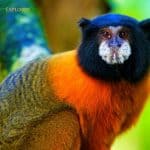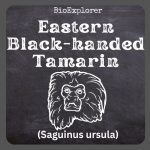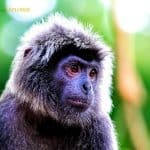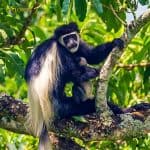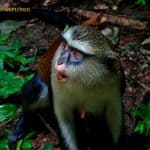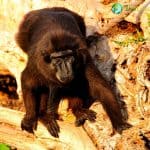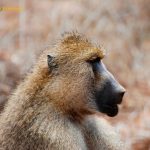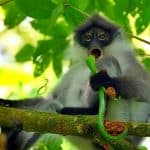top - search results
If you're not happy with the results, please do another search
Milton’s Titi
Milton's titi (Plecturocebus miltoni) also called the fire-tailed titi monkey, is a species of titi, a type of New World monkey from the Amazon rainforest of southern Brazil.
Rio Beni Titi
The Rio Beni tití is a New World monkey species belonging to the genus Callicebus of the family Pitheciidae. It is native to Bolivia and is found mainly in the eastern parts of Bolivia in the upper basins of the Mamoré and Grande rivers.
White-tailed Titi
White-tailed titi monkeys, also called red titi monkeys or red-crowned titis and not to be confused with coppery titi (Callicebus cupreus), also commonly known as red titi, are endemic to the dense rainforest and gallery forests of Peru and Ecuador.
Ryland’s Bald-faced Saki
The Ryland's Bald-Faced Saki (Pithecia rylandsi) is a controversial species of saki monkey, a New World monkey species. It is one of the largest sakis. This South American monkey was named after Brazilian primatologist Anthony Rylands, a former professor of vertebrate zoology at the Federal University of Minas Gerais and founding editor of the journal Neotropical Primates.
Wied’s Marmoset
The Wied's marmoset (Callithrix kuhlii), also called the Wied's black-tufted-ear marmoset, is a New World monkey that lives in the tropical and subtropical forests of eastern Brazil. Unlike other common marmosets, Wied's marmosets live in groups consisting of 4 or 5 females and 2 or 3 males (plus juveniles).
Variegated Spider Monkey
The Variegated spider monkey or brown spider monkey (Ateles hybridus) is an endangered species of spider monkey, a species of New World monkey endemic to the forests of northwestern Venezuela and northern Colombia.
Vanzolini’s Bald-faced Saki
Vanzolini's Bald-Faced Saki (Pithecia vanzolinii) is a species of saki monkey, a species of New World monkey. Vanzolini's bald-faced saki monkey was first cataloged by naturalist Alfonso Ollala in 1936. His account describes a monkey with a long, fluffy tail and golden fur on its limbs.
Urubamba Brown Titi
The Urubamba brown titi (Plecturocebus urubambensis) is a species of Titi, a New World monkey native to Peru. This species is found east of the Tambo River and west of the Urubamba, Manú, and Madre de Dios rivers.
Bearded Saki
The bearded sakis or cuxiús are five species of New World monkeys classified in the genus Chiropotes. Bearded saki shows slight sexual dimorphism: males are usually taller and have longer, more prominent beards than females.
Prince Bernhard’s Titi
Prince Bernhard's Titi (Plecturocebus bernhardi) is a species of titi in the subfamily Callicebinae. It is a species of New World monkey native to Brazil. The species is named after Prince Bernhard of the Netherlands, a naturalist who established the Order of the Golden Ark to honor conservationists worldwide.
Peruvian Yellow-tailed Woolly Monkey
The Peruvian yellow-tailed woolly monkey (Lagothrix flavicauda), also called the yellow-tailed woolly monkey, is a New World monkey native to Peru. Peruvian yellow-tailed woolly monkey is among the rarest Neotropical primates and one of the largest mammals endemic to Peru.
Parecis Titi
The Parecis titi (Plecturocebus parecis) is a species of titi, a New World monkey native to Brazil. The range of the new species is in the deforestation arc of the Amazon, where large tracts of forest are being destroyed for timber, settlements, and industrial agriculture.
Neblina Uakari
The Neblina uakari (Cacajao hosomi), black-headed uakari, is a recently described monkey species from the extreme northwest of the Brazilian Amazon and adjacent southern Venezuela. Neblina uakari's English name refers to the Pico da Neblina, which marks its known distribution approximate center.
Maranhão Red-Handed Howler
The Maranhão red-handed howler (Alouatta ululata) is native to forests (e.g., Babaçu forests) in the northeastern Brazilian states of Piauí, Maranhão, and Ceará. Red-handed howler monkeys are among the least studied species of all howler monkeys.
Madidi Titi
The Madidi titi also called the Golden Palace monkey, is a titi, a New World species of monkey discovered in 2004 in Madidi National Park in western Bolivia. The species got its name, Golden Palace, from an online casino after an auction.
Lesson’s Saddle-Back Tamarin
Lesson's Saddle-Back Tamarin (Leontocebus fuscus) is a small New-world monkey endemic to South America. Its type locality is in Colombia, on the plains of Mocoa, Putumayo, between the Caquetá River and the Putumayo River.
Lake Baptista Titi
The Lake Baptista titi, Plecturocebus baptista, is a species of titi, a New World monkey native to Brazil. Lake Baptista Titi was initially described as Callicebus baptista in 1939.
Kaapori Capuchin
The Kaapori capuchin (Cebus kaapori) also known as Ka'apor Capuchin, is a capuchin monkey native to Brazil. Previously considered a subspecies of the wedge-capped capuchin monkey (Cebus olivaceus), it was elevated to species status recently.
Isabel’s Saki
Isabel's Saki (Pithecia isabela) is a New World monkey species, native to a small part of northern Peru. The species was named in honor of Isabel Godin des Odonais, an 18th-century Ecuadorian noblewoman who traveled across South America to find her husband.
Hairy Saki
The hairy saki (Pithecia hirsuta) is a species of saki monkey, a New World primate species. The species was identified by Johann Baptist von Spix in 1823 but later merged with the Mönk saki (P. monachus). Then, a 2014 study revived it as a separate species due to differences in fur coloration.
Red-backed Bearded Saki
The red-backed bearded saki (Chiropotes chiropotes), also known as Guianan Bearded Saki, is a New World monkey native to South America. They live in groups of about 40 members of both sexes, sometimes separated into groups when traveling or foraging, their primary occupation.
White Marmoset
The white marmoset (Mico leucippe), also called the golden-white bare-eared marmoset, is an endangered marmoset native to the Amazon rainforest of Pará, Brazil.
Golden-mantled Tamarin
The golden-mantled tamarin (Leontocebus tripartius) is native to South America. The golden-mantled tamarin is an arboreal, diurnal species that leaps and walks quadrupedally through the undergrowth.
Gold-And-White Marmoset
The gold-and-white marmoset, also called the golden-white tassel-ear marmoset, is a species of marmoset, a tiny monkey native to the Amazon rainforest in the eastern Amazonas state of Brazil.
Ecuadorian Squirrel Monkey
The Ecuadorian squirrel monkey is a species of the squirrel monkey. Although it occasionally ventures to the ground to play or feed, the Ecuadorian squirrel monkey is strictly an arboreal primate.
Eastern Black-handed Tamarin
The Eastern black-handed marmoset (Saguinus ursulus) is a species of marmoset native to Brazil. These tamarins are mainly covered in jet-black fur, with only a small area around the nose and eyes and most hairless ears.
Collins’ Squirrel Monkey
Collins' Squirrel Monkey is a species of squirrel monkey endemic to Brazil. Until a genetic study by Jessica Lynch Alfaro et al. raised them to the species category, Collins' squirrel monkey had been considered a subspecies of the squirrel monkey (Saimiri sciureus).
Collared Titi
The collared titi, also called the widow monkey, or yellow-handed monkey inhabits the lush rainforests of the Amazon and is typically found south of Río Negro and north of Río Solimões. Titi monkeys are often known to "duet" with each other, either between an adult female and an adult male, an adult female and her son, or an adult male and his daughter.
Coimbra Filho’s Titi
or Coimbra titi is a species of titi, a New World primate native to the forests of the Brazilian states of Sergipe and Bahia. It is named in honor of Adelmar F. Coimbra-Filho, founder and former director of the Rio de Janeiro Primate Center, for his Brazilian biology and primatology work.
Coastal Black-handed Titi
The coastal black-handed titi is another species of titi, a New World primate native to the Atlantic Forest of northeastern Brazil. Coastal black-handed Titi monkeys vocalize synchronously early in the morning, possibly to announce their presence in their territory.
Chacoan Titi Monkey
The Chacoan Titi Monkey is a species of titi (also called White-coated Titi), a type of New World monkey native to South America. These diurnal monkeys are stealthy and hard to spot as they navigate the canopy. They move between branches and trees by walking or jumping on four limbs.
Caquetá Titi
The caquetá titi also called the bushy-bearded titi or red-bearded titi, is a species of titi monkey native to Colombia in the Caquetá region. Dr. Marta Bueno, Thomas Defler, and their student Javier García of the National University of Colombia are credited with the 2008 discovery of the Caquetá-Titi monkey.
Burnished Saki
The Burnished saki is a species of saki monkey, a species of New World monkey. It is located in central Peru and a small part of adjacent Brazil. The species was described by Johann Baptist von Spix in 1823 but was later merged with the monk saki (Pythecia monachus).
Buffy-tufted Marmoset
The buffy-tufted marmoset, also called the white-eared marmoset or buffy-tufted-ear marmoset is a New World monkey living in the forests of the Atlantic coast of southeastern Brazil. Unlike most marmoset monkeys, buffy-tufted-ear marmosets are mainly insectivorous, although their diet is generally carnivorous.
Brown-backed Bearded Saki
The brown-backed bearded Saki is one of 5 species of bearded Saki, a New World monkey species. Bearded sakis have a unique appearance. They are born with prehensile tails, which they retain for the first two months of their life. This allows them to cling to their mother's body. After this time, the tail becomes non-prehensile.
Ashy Black Titi
The Ashy black titi is a species initially described in 1823 as Callicebus cinerascens. Ashy black titi monkeys live in small families comprising a monogamous pair and their young. Adult males tend to carry their infants unless the mother is nursing.
Alta Floresta Titi
The Alta Floresta titi is a distinct but unnamed form of titi (Plecturocebus) rediscovered in 2019 in Chapada dos Parecis, a plateau in the far south of the Brazilian state of Rondônia. This species lives exclusively between the Teles-Pires and Juruena rivers in Mato Grosso.
Tonkin Snub-Nosed Monkey
The Tonkin snub-nosed monkey, also known as the Dollman's snub-nosed monkey (Rhinopithecus avunculus), is a slender-bodied Old World arboreal monkey native to northern Vietnam.
Red-bellied Monkey
The red-bellied monkey (Cercopithecus erythrogaster), also called the red-bellied guenon or white-throated guenon is a diurnal primate living in the trees of tropical rainforests or tropical areas in Benin and Nigeria. The red-bellied monkey was once considered extinct due to constant hunting for fur on its unique red belly and white front legs.
Natuna Island Surili
The Natuna Island Surili (Presbytis natunae) is a primate species in the Cercopithecidae family. The species is native to the Indonesian island of Natuna Besar. The species is native to the Indonesian island of Natuna Besar.
Lesula
The lesula (Cercopithecus lomamiensis) is a species of Old-World monkey occurring in the Lomami Basin of the Congo. This monkey is described as having human eyes and a blue bottom.
Javan Surili
The grizzled surili (Presbytis comata) is a threatened species of Old World monkey native to the western half of Java, Indonesia, a biodiversity hotspot. The grizzled surili engages in 3 to 4 foraging and feeding fights throughout the day.
Mount Kilimanjaro Guereza
The Mount Kilimanjaro guereza (Colobus caudatus) is one of the 7 subspecies of the mantled guereza. It is found in Kenya and Tanzania in the forests surrounding Mount Meru and Mount Kilimanjaro.
Tantalus Monkey
The tantalus monkey (Chlorocebus tantalus) is an Old World monkey endemic to Africa, ranging from Ghana to Sudan. It was initially described as a subspecies of Grivet (Chlorocebus aethiops). Tantalus monkeys are very similar to vervet monkeys but are smaller in size.
Tana River Red Colobus
The Tana River red colobus (Piliocolobus rufomitratus), also called the eastern red colobus, is a critically endangered primate species in the Cercopithecidae family. The Tana River red colobus monkeys are the only one of 18 species of red colobus that do not live in the tropical rainforest.
Pennant’s Red Colobus
Pennant's Colobus or Pennant's Red Colobus (Piliocolobus pennantii) is a species of arboreal primate in the Cercopithecidae family. Like other red colobus monkeys, the Pennant's red colobus lives in flocks that may consist of 12 to 80 individuals occupying a territory of 25 to 150 hectares.
Niger Delta Red Colobus
The Niger Delta red colobus (Piliocolobus epieni) is a critically endangered colobus native to the western part of the Niger Delta in southern Nigeria. The scientific name of the Niger Delta red colobus, Piliocolobus epieni, comes from the local Ijaw language word for the species, "epieni".
Lang’s Red Colobus
Lang's red colobus (Piliocolobus langi) is another species of red colobus monkey. Historically, it was treated as a subspecies of the Central African red colobus (Piliocolobus foai). Still, more recent taxonomies generally treat it as a distinct species.
Shan State Langur
Shan State Langur was generally considered a subspecies or a synonym of Phayre's leaf monkey (Trachypithecus phayrei) until Roos et al. elevated it to species status in 2020.
Cross Marked Langur
The Sarawak surili, also known as Cross-marked Langur, is a monkey species in the Cercopithecidae family. The Sarawak surili was once considered widespread but has declined significantly due to habitat and loss persecution.
Black and White Langur
The black-and-white langur is a primate species in the Cercopithecidae family. It was formerly thought to be a subspecies of the Presbytis melalophos (black-crested Sumatran langur). Still, the genetic analysis indicated they were separate species.
Vervet Monkey
The vervet monkey (Chlorocebus pygerythrus) is an Old World monkey of the Cercopithecidae family endemic to southern and eastern Africa. Not only can vervet monkeys skilfully navigate through the treetops, but they can also swim.
Schmidt’s Red-tailed Monkey
The Schmidt's red-tailed monkey, also called the red-tailed guenon, Schmidt's guenon, or black-cheeked white-nosed monkey is a primate species in the Cercopithecidae family. The Schmidt's red-tailed monkey is named for its red coloration on the underside of its tail, as well as the bicolor coloration of its tail as the reddish color increases from the base to the tip.
Heck’s Macaque
The Heck's Macaque (Macaca hecki) is a macaque native to Sulawesi, Indonesia. This Old-World monkey is diurnal. Due to their frugivorous diet, Heck's macaques will likely act as seed dispersers throughout their habitat.
Gorontalo Macaque
The Gorontalo macaque (Macaca nigrescens), also called the Dumoga-bone macaque, is a species of the primate of the Cercopithecidae family. It is native to the Sulawesi Island of Indonesia.
Baboons
Baboons are another breed of Old-world monkeys classified under the genus Papio. There are 6 types of baboons. Explore all about baboons here.
Yellow Baboon
The yellow baboon (Papio cynocephalus) is another baboon species in the group of Old World monkeys. They resemble the Chacma baboon but are slightly smaller and have a less elongated snout. Yellow baboons also have white fur on internal surfaces, such as their cheeks and limbs, similar to the color of the human forearm.
What Do Goldfinches Eat? Explore Goldfinch Diets, Hunting & Eating Habits
Goldfinches are mainly omnivores. Explore in detail what do Goldfinches eat by their types, hunting techniques, what eats Goldfinches & more.
Popa Langur
Popa langur (Trachypithecus popa) is a primate species in the Cercopithecidae family. It occurs exclusively in Myanmar. The species is named after Mount Popa, where a population of 100 monkeys lives.
Pale-Thighed Langur
The pale-thighed surili (Presbytis siamensis), also called the white-thighed langur, is a primate species in the Old World monkey family (Cercopithecidae). Pale-thighed langurs are savvy herbivores; it's fun to say they only eat plants and have a fussy palate, with a preference for young leaves, seeds, and fruits.
























